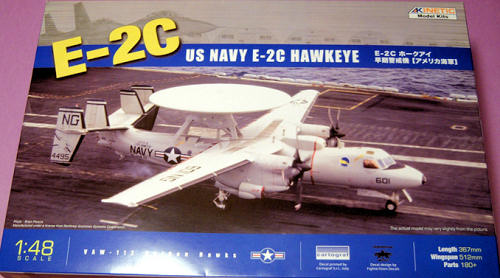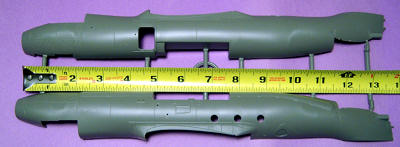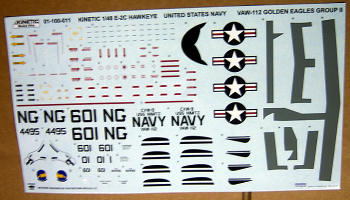
Kinetic 1/48 E-2C Hawkeye
| KIT #: | K4013 |
| PRICE: | $94.95 MSRP |
| DECALS: | One option |
| REVIEWER: | John Lester |
| NOTES: | New kit, completely injected plastic |

| HISTORY |
As far back as 1942, the US Navy
recognized the need for what is now called an Airborne Early Warning (AEW)
platform. The first were TBM Avengers modified to carry 2 operators,
state-of-the-art AN/
Everyone realized that designing the first purpose-built AEW platform would be an enormous challenge – and it was. In addition to technology, the aircraft had to be able to operate from the older, smaller Essex-class carriers, which constrained the new aircraft’s size and weight. It wasn’t until 1964 that the first E-2As joined the fleet. They almost left it in 1965; the aircraft’s systems were so unreliable that production was halted and later all E-2As were grounded for a time. Eventually the problems were resolved, mainly through upgrades to computers and cooling systems. These resulted in the E-2B, which at last gave the Navy what it had wanted since 1942.
The navy wasn’t done with upgrades, though. The E-2C program kicked off in 1968, and the new aircraft joined squadron service in 1974. To accommodate all the technology changes within the airplane, the nose was lengthened and reshaped, the boat tail redesigned, and a new, larger cooling scoop provided. The four vertical fins were enlarged as a result of the installation of new engines as well. Since then, the E-2C has been continually upgraded, partially through conversion of older airframes and partially through new builds. Most of these improvements are inside the aircraft’s skin; visible changes in the most current variant, called the “Hawkeye 2000”, include new 8-bladed propellers made from composites, various lumps and bumps for new antennas, and a new battlespace management system that is partially housed in a bulged section underneath the fuselage at the middle of the plane. By now, all active duty aircraft have been upgraded to Hawkeye 2000 standard. The next iteration in E-2 development, the heavily revised E-2D, first flew in August 2007 and is slated to enter the fleet in 2012-13.
In addition to the US Navy, E-2s have flown with the US Coast Guard, Egypt, Israel, Mexico (ex-Israeli aircraft), Taiwan, Japan, Singapore, and France. All were E-2C or upgraded to E-2C standard (subject, of course, to technology transfer limitations) and many have been upgraded to “Hawkeye 2000” standard. India and The United Arab emirates have expressed interest in the E-2D.
| THE KIT |
 Kinetic’s new E-2C is the first kit of this aircraft in 1/48 scale.
You get a lot of plastic for your money – so
much so it’s hard to get it all back in the box after the initial sprue
fondling session!
There are 14 sprues of plastic parts (170 or so
grey and 14 clear), all packed in one bag - but at least the clear parts are
in their own sealed bag.
Make sure you check your parts carefully – my
sample is missing three small bits that broke off the sprues and were not
found in the main bag.
A very large decal sheet, 12 page instruction
booklet, and large black-and-white decal placement guide are also included.
Kinetic’s new E-2C is the first kit of this aircraft in 1/48 scale.
You get a lot of plastic for your money – so
much so it’s hard to get it all back in the box after the initial sprue
fondling session!
There are 14 sprues of plastic parts (170 or so
grey and 14 clear), all packed in one bag - but at least the clear parts are
in their own sealed bag.
Make sure you check your parts carefully – my
sample is missing three small bits that broke off the sprues and were not
found in the main bag.
A very large decal sheet, 12 page instruction
booklet, and large black-and-white decal placement guide are also included.
Construction options include:
- Folded or extended wings – a welcome bonus on a kit with a 20” (508mm) wingspan. Separate pieces for the outer wing panels (and of course the wing structure at the folds) are provided, so no surgery is required. A hefty spar on each side ensures the wing won’t fall apart whether you pose extended or folded.
- Ailerons and flaps may be displayed down or, by cutting off the mounting tabs, retracted.
- Positionable crew door. No interior is provided (aft of the flight deck, anyway) but a plug (part G-32) provides enough simulated detail to satisfy most builders.
- Separately molded escape hatches on the canopy, which may be posed “open” to show off flight deck detail. The bulged canopy side windows are also provided separately.
- Positionable arrestor hook
- Radome may be rotated
- Two different styles of engine cowling panels (standard or reinforced)
-
Separate belly panels, one
with the unmodified E-2C section and one with the bulged
- Parts are provided for Japanese and French variants, and are called out in the instructions. Parts are also provided for the Hawkeye 2000’s
Detail throughout is pretty good. The flight deck is a bit simplified, but not a lot will be visible through the canopy, even with the escape hatches open. The landing gear and their bays are appropriately busy, and the various scoops and intakes have nice interior detailing. The nose cap is molded clear, so all you have to do is mask off the landing light cap when you paint. Weighted, but thankfully not bulged, tires are provided.
 Surface
detail consists of engraved panel lines and, where appropriate, rivets.
The panel lines are a bit wider and a bit deeper
than I really care for – though it’s not as if they were done with a plow as
on the old Matchbox kits.
They should look OK under a coat of paint.
With the exception of a few circles in the gear
wells, ejector pin marks are where they won’t be seen on the completed
model.
Some of the sprue attachment points are pretty hefty;
you will want to use a razor saw or similar to cut parts free, rather than
breaking out industrial strength nippers and potentially damaging the
pieces.
I’ve only taped a few of the major assemblies together
so far, but fit appears to be good.
Surface
detail consists of engraved panel lines and, where appropriate, rivets.
The panel lines are a bit wider and a bit deeper
than I really care for – though it’s not as if they were done with a plow as
on the old Matchbox kits.
They should look OK under a coat of paint.
With the exception of a few circles in the gear
wells, ejector pin marks are where they won’t be seen on the completed
model.
Some of the sprue attachment points are pretty hefty;
you will want to use a razor saw or similar to cut parts free, rather than
breaking out industrial strength nippers and potentially damaging the
pieces.
I’ve only taped a few of the major assemblies together
so far, but fit appears to be good.
The aircraft, as presented, represents
a Group II upgrade in service during the 1990’s.
It w ould
not be hard to model any of the Group 0, I or II versions used from 1974
through the early 2000’s, as most of the detail differences are internal
(still, you’re going to want to check your references for the various
antennas and such).
The parts breakdown – in particular the bulged
belly midsection piece and the props on separate sprues – indicate
that a Hawkeye 2000 version is probably in the works.
You can’t, however, easily backdate this kit to
an E-
ould
not be hard to model any of the Group 0, I or II versions used from 1974
through the early 2000’s, as most of the detail differences are internal
(still, you’re going to want to check your references for the various
antennas and such).
The parts breakdown – in particular the bulged
belly midsection piece and the props on separate sprues – indicate
that a Hawkeye 2000 version is probably in the works.
You can’t, however, easily backdate this kit to
an E- 2A
or E-2B version (so no Israeli aircraft) due to the different nose, tail,
engines and cooling systems. (Isradecals
#82 states that Israel operated 4 E-2Cs from 1978-1994. Ed)
2A
or E-2B version (so no Israeli aircraft) due to the different nose, tail,
engines and cooling systems. (Isradecals
#82 states that Israel operated 4 E-2Cs from 1978-1994. Ed)
Decals were developed by Fightertown Decals and printed by Cartograf. Markings are for one aircraft of VAW-112 “Golden Eagles” in overall grey (FS16440) aboard USS Nimitz in 1995. In addition to BuNo and squadron markings, they include tail stripes, walkways, anti-glare panel, prop tips and about a gazillion data and warning stencils. All decals are in perfect register and have good color density.
| CONCLUSIONS |
It looks like Kinetic have a winner in this kit. Decent is sufficient for most of us while leaving room for the super detailers to go to town. Thoughtful engineering and lack of resin and brass make for a kit that most modelers with modest skills can complete to a high standard, though the high parts count and a number of tiny bits will provide a challenge. Experience building the latest from Hasegawa and the like will definitely be a plus with this kit.
Recommended.
Many thanks to Kinetic for the review sample.
| REFERENCES |
http://www.spyflight.co.uk/hawkeye.htm
http://en.wikipedia.org/wiki/E-2_Hawkeye
http://www.vectorsite.net/ave2c.html
January 2010
If you would like your product reviewed fairly and quickly, please contact me or see other details in the Note to Contributors.